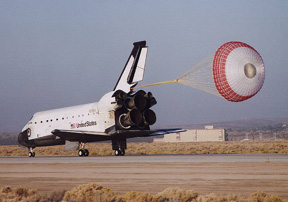Click on image for full size
Courtesy of NASA
Related links:
Shuttle Returns Safely
News story originally written on May 7, 1998
The shuttle Columbia recently returned after 16 days in space. Some interesting things happened upon landing!First, five of the seven crew members were carried off of the shuttle in stretchers. Scientists hoped that by keeping the crew members off their feet, their weightless state would be preserved. That way, scientists could do some immediate medical tests.
There were many other scientists waiting at the landing site. In fact, 200 researchers awaited Columbia's arrival so they could begin dissecting the animals that had traveled aboard the shuttle. Scientists would work with 2,000 fish, snails, crickets and other rodents that flew as part of Columbia's Neurolab. A few dozen baby rats were also of interest. It was a race against gravity: the sooner the astronauts and animals could be tested, the greater the chance of seeing microgravity's effect on the nervous system.
You may wonder why there was all of this fuss upon Columbia's landing. The Neurolab that was aboard this mission is of extreme importance. Beyond expanding our knowledge of the neurological system (the most complex system of the body composed of the brain, spinal cord, peripheral nerves and sensory organs), the Neurolab is likely to aid in advances in many medical areas. Areas in which we are likely to advance due to research aboard the Neurolab are motion sickness, vertigo, orthostatic intolerance, muscular dystrophy, and even insomnia.















